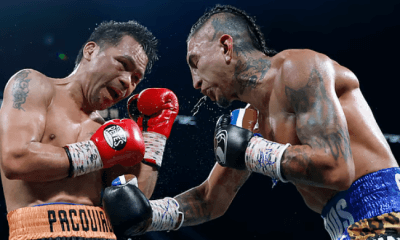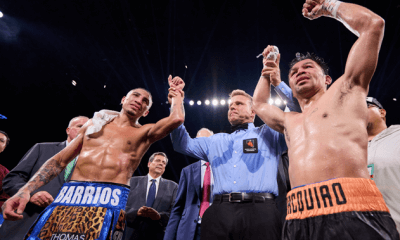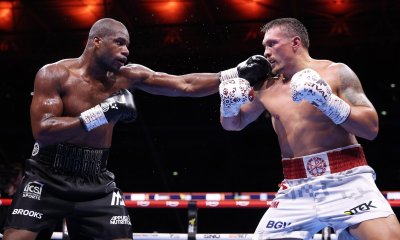Articles of 2006
The Mirror of 1986 – Part III
Heavyweights love to make comebacks. Young-ish old ones and old-ish old ones, they are all compelled by money not yet earned, titles lost or never won, nebulous thoughts of revenge or renaissance like so many sparks of interest – not really passion – dancing by fraudulent flames of desire. Gerry Cooney, never world champion but massive in size and name recognition, couldn’t seem to stay retired, his June 11, 1982 loss to Larry Holmes still festered as a personal humiliation in 1986. Intermittently, Cooney couldn’t resist talking himself up as a still unfinished project in the making, a man capable of taking the heavyweight championship on his best night. Though his pro record partially supported this semantically correct claim, most boxing fans realized he’d last been in a boxing ring in December, 1984, against 22-6-2 George Chaplin for less than two rounds.
Where was the commitment fight fans wanted to know? So in May, almost on cue, Cooney lumbered out of his latest sabbatical to punch it out with 6’5” Eddie Gregg, at least allowing Team Cooney to say they were picking on someone his own size. And Gregg was a respectable-looking 27-1, having only lost to once beaten James Broad. Of course Broad’s only loss was to Marvis Frazier, so that should have been a red flag. At any rate, Cooney and Gregg faced off at The Cow Palace, an appropriate enough venue, in San Francisco, California. The scheduled 10 round contest lasted 1:26 according to the official time keeper, Cooney barely having enough time to remember the fight plan before getting to the finale. So much for keeping active! The ‘fight’ having the merit of a simulation, something just below the significance of a good sparring session, marginally more than shadowboxing in front of a wall mirror.
The winner and his management team promised this was just the start of Cooney’s renewed commitment to becoming heavyweight champion of the world, a dream the Huntington, New York heavyweight had never given up on. He couldn’t. To give up on the figment of that dream was to give up on the expressed purpose of his professional life, his public self. Only once defeated and only 30, Cooney couldn’t dispose of that mental projection, no matter how incongruously fitted his sense of athletic purposefulness and the day to day realities of bearing up to the rigors of absolute dedication. That dichotomy of character and action was the real battle for supremacy Cooney would have to win to ever make a reality out of what he said he most desired; he was fighting one of the eternal fights in the history of boxing.
Bob Arum showed himself a preeminent promoter when his company Top Rank staged a triple header at Caesars Palace in Las Vegas in June with headliners Roberto Duran, Thomas Hearns and Irish featherweight fan favourite Barry McGuigan. McGuigan would later say it was the blazing heat of the desert in summertime as much as the boxing aplomb of Californian Stevie Cruz that took him from celebrated champion to dehydrated ex-WBA champion, as the Clones Cyclone lost a thriller 15 round decision in what many regarded as the action fight of the year for 1986. Not even the public criticism of Dr. Adrian Whiteson of the British Boxing Board of Control (BBBC) of the McGuigan-Cruz fight being contested in 100F heat could restitute McGuigan’s fortunes in boxing.
When Roberto Duran puffed and panted through 10 lackluster rounds to drop a ten-round decision to Marvin Hagler’s half-brother Robbie Sims, the career of “Hands of Stone” had all the weight and substance of a mirage. Duran’s own weighty issues had become the subject of constant ridicule; the Panamanian legend himself seen to be fighting on for the purposes of paying off sundry debts, back taxes, while chasing a modicum of redemptive contrition for the blighting sin that his “No Mas” surrender to “Sugar” Ray Leonard had become for fans of sport as well as boxing fans. Hearns simply continued his campaign of winning, partially concealed at 154, still eyeing a return to middleweight and his chance to revisit the lost struggle against the marvelous one, Marvin Hagler. If Hagler’s fixation was ripping through the legend of Ray Leonard, Hearns calculated his career would need a redressed result against both Hagler and Leonard. Without much resistance, Hearns stopped Mark Medal in 8 rounds, leading at the time of the stoppage on all three cards in a runaway.
Marvin Hagler and the Petronelli brothers were frustrated at their inability to get a deal done with Ray Leonard’s brilliant lawyer Mike Trainer. Marvin Hagler’s wife came out publicly with her opposition to her husband continuing on in boxing. The middleweight champion toyed with the press telling them he was seriously considering retirement and that he was frustrated with Leonard’s negotiating-non-negotiating; he threatened to retire and leave the matter of his fight with the Sugar Man and a Hearns rematch to the imagination of his fans. Concurrently, the California State Athletic Commission confirmed the new law requiring boxers to pass annual neurological tests, adding for public notice of former WBC featherweight champion Bobby Chacon’s indefinite suspension from boxing stemming from repeated arrests for assault. The suspension would keep Chacon out of boxing for only a year and a half.
Boxing had been riding a fairly good winning streak, considering how successful boxing promotions below heavyweight had been for a decade, highlighting the careers of Roberto Duran, Ray Leonard, Wilfred Benitez, Thomas Hearns, Marvin Hagler, Matthew Saad Muhammad, Pipino Cuevas and Carlos Palomino. Arum’s rival promotional force was Don King, who was plotting a heavyweight championship box-off to once again bring the heavyweight championship back to a place of unsurpassed significance in boxing; King’s designs centered round his superstar in waiting, “Iron” Mike Tyson, the teenage Sports Illustrated cover boy wrecking ball who was slated to smash his way through the champions of the big boy’s division. With Don King angling to promote, Cus D’Amato to train, Jimmy Jacobs and Bill Cayton to manage, Mike Tyson’s dream team looked secure.
1984 Olympic bronze medalist Evander Holyfield proved he really was “The Real Deal” when he took an 11-0 professional record into the ring with him to face the daunting challenge of cruiserweight champion Dwight Muhammad Qawi, aptly nicknamed the Camden Buzzsaw. Holyfield showed maturity and composure beyond his years in earning a bruising 15-round split decision and the WBA cruiserweight championship. Holyfield, never content with his achievements, gave notice to the heavyweights that he was on his way, taking it one title, one division at a time. For his part Mike Tyson began to run the heavyweight table with a savage first round – 30 second – demolition of Marvis Frazier, effectively ending the career of the son of former world champion Smokin’ Joe Frazier, with a still green Jim Lampley doing the blow-by-blow for ABC television.
When Tyson dismissed Jose Ribalta and Alonzo Ratliff within three weeks of each other, everyone in boxing could see the freight train coming down the tracks and it was to stop at Berbick station in November. The Jamaican-Canadian Trevor Berbick trained as if his life depended on it and within a minute it did. Primed from a dressing room pep talk by Roberto Duran to go out there and “rip him up early,” Tyson had the man who’d gone fifteen rounds with Larry Holmes doing a break dance at ring center before some in the audience had adjusted to the garishly overheated ring lights that night.
With Tyson’s coronation it was easy to miss the arrival of Michael Nunn to the middleweight scene; his ordaining moment coming at the expense of good guy Alex Ramos. Yes, Hagler and Leonard’s teams had finally come to an agreement in the late fall of 1986, so that little piece of the historical puzzle was set to be forced into place after all. Leonard’s joust with an anxious and aging Hagler, though, would be for another season. The seasons of Larry Holmes, he believed in 1986, had turned from an autumnal flourish to a winter of some lingering discontent. Still smarting from the decision loss to Michael Spinks and feeling his age, 37, Holmes almost in anonymity announced his retirement in the first week of November, though almost no one in boxing took him at his word, for they had come to know the man from Easton, Pennsylvania far too well.
The winter is always followed by spring and the coursing surges of blood that mimics the stridency of youth.
-

 Featured Articles3 weeks ago
Featured Articles3 weeks agoThe Hauser Report: Zayas-Garcia, Pacquiao, Usyk, and the NYSAC
-

 Featured Articles2 weeks ago
Featured Articles2 weeks agoOscar Duarte and Regis Prograis Prevail on an Action-Packed Fight Card in Chicago
-

 Featured Articles1 week ago
Featured Articles1 week agoThe Hauser Report: Cinematic and Literary Notes
-

 Book Review6 days ago
Book Review6 days agoMark Kriegel’s New Book About Mike Tyson is a Must-Read
-

 Featured Articles4 weeks ago
Featured Articles4 weeks agoManny Pacquiao and Mario Barrios Fight to a Draw; Fundora stops Tim Tszyu
-

 Featured Articles4 weeks ago
Featured Articles4 weeks agoArne’s Almanac: Pacquiao-Barrios Redux
-

 Featured Articles3 weeks ago
Featured Articles3 weeks agoRemembering Dwight Muhammad Qawi (1953-2025) and his Triumphant Return to Prison
-

 Featured Articles4 weeks ago
Featured Articles4 weeks agoOleksandr Usyk Continues to Amaze; KOs Daniel Dubois in 5 One-Sided Rounds















